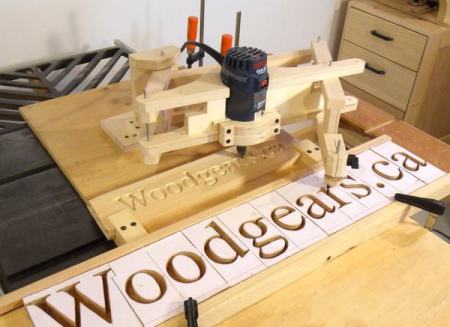It seems that there is no end to ingenious woodworking tools, such as this 3-D Router Pantograph from [Woodgears.ca]. The pantograph, a design using linkages to trace and scale drawings, may have been invented in the 1600s, but if we were honest, most of us haven’t heard of this device. This particular pantograph is able to trace letters or other stencils in three dimensions by pivoting about an additional axis.
If you’re wondering where to get these stencils, they’ve got you covered with an online stencil generation tool. However, if you want to make even more detailed stencils, we might recommend using a free drafting tool such as Draftsight (here’s a review), or Sketchup.
[Woodgears] gives a good explanation of how it’s made in the video after the break. You can also buy plans for it if you want templates to use to cut everything.
[youtube http://www.youtube.com/watch?v=iUGkroZus_Y%5D
On the other hand, if you’re feeling a bit more (or less depending on your skill set) adventurous, you could always try building a CNC router!
















Woodgears is an absolutely awesome site which I suggest everyone here should have a look at.
The projects posted there are essentialy the same as the ones here except that they’re all made of wood. :P
Nice I had one of these as a kid well a lot smaller and user a pencil instead of a Dermal we used it to trace and scale up or down pictures from book ect.
I also know I had a engrafting done once he used the same concept he had boxes of different fonts cnc`ed in little plexy squares
Might build one for “freehand” projects
I think most of us had one of these as a kid, I think the ‘never heard of these’ folk are in the minority (ie HAD writers).
Yep, had one also.
Was it a K-tel E-Z Tracer?
http://youtu.be/sUOxBJvT41Q
Close enough. Mine was made from orange plastic, and did a really crappy job.
Really cool, but… why not a CNC?
Because most woodworkers don’t know and don’t care about stepper motors, position control circuits and power supplies?
See http://woodgears.ca/bandsaw/cnc.html for his position on CNC.
In the days before CNC, just about every good die or mold shop had a surface grinder setup with a pantograph wheel dresser. Moore Tool used to make some nice ones. Not too much more complicated than this setup with the addition of rotation between the stylus in the template and the diamond point dressing the shape on the grinding wheel. The radius on the front of the tracing stylus matched the radius on the diamond point. We would make templates out of aluminum or sheets of softer steel, rough with a bandsaw, finish with riffler files or on another grinder, check and double-check in an optical comparitor/shadowgraph. Really useful for making things like gear hobbs and broaches, we had quite a library of gear tooth templates.
Last time I used the pantograph grinder, I cheated and WireEDM the template.
That is very cool. One thing though – if you wanted a small enough tolerance you’d have to modify your track width depending on the distance to the back pivot to keep a constant depth in the production piece.
Craftsman sells this tool for about $50. http://www.craftsman.com/craftsman-deluxe-router-pantograph/p-00925187000P
Badass use of a plane at 3:00!
FWIW, I’ve been following this guy for quite some time. He was an engineer with a company called RIM in the early days, but decided to follow his passion for woodworking. While he’s certainly capable of understanding CNC, he – as John stated above – doesn’t really care. His genius is in his simplicity. I agree with Tom – the site is definitely worth checking out.
Agreed. I have been following him for a while as well. He solutions continue to impress me, particularly since everyone has gone CNC crazy. Nothing wrong with CNC at all, but I like his non-CNC approach that ends up being more impressive.
I’ve got a smaller one of these that I got from a sign company for making name tags. The Router is more Dremel size, and the letters are 3/4″ plastic, but basically the same thing.
Digression – yep – had one as a child, but also knew that the armature on trams that connected to the overhead wires was called a pantograph. Perhaps trams are rare in your cities?
A nice project well executed and a wealth of information at woodgears. Awed.